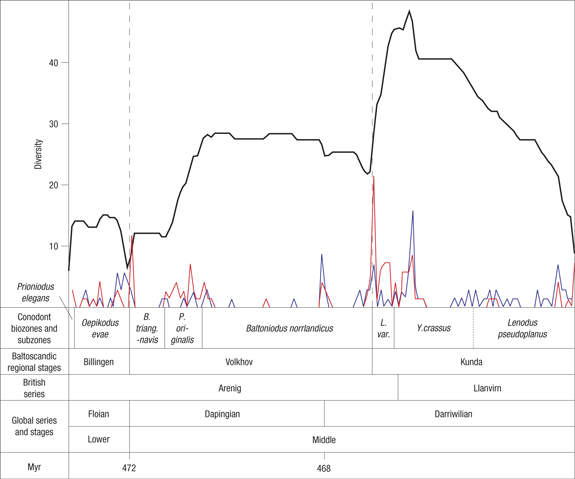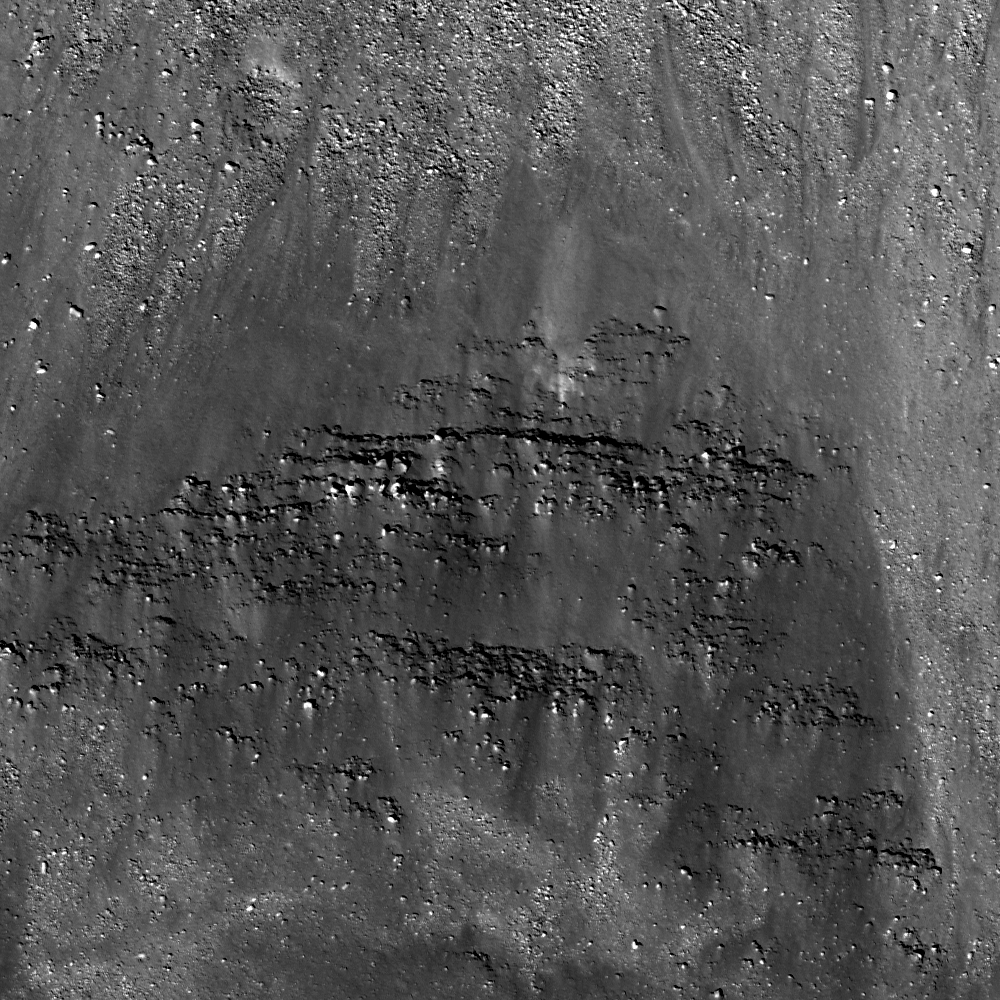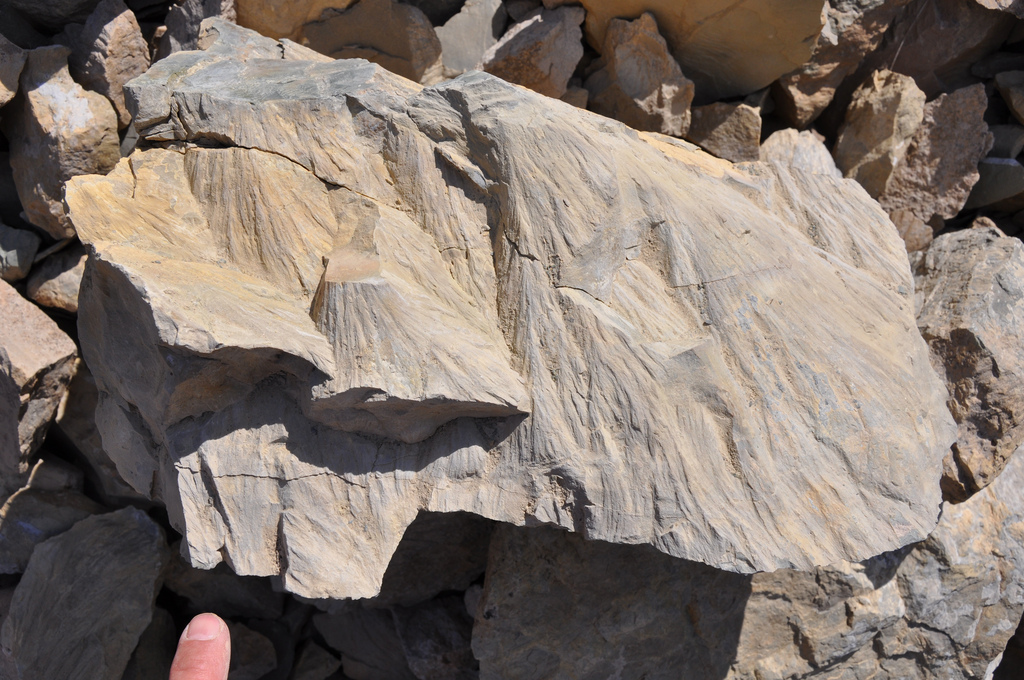Between Mars and Jupiter, 470 million years ago, there was a massive collision between two 100km-sized chunks of rock – this solar system’s biggest bang of the last billion years. It created a massive cloud of smaller fragments. Some of these landed on the earth, falling at a rate at least a hundred times greater than at present. These fragments can be found today in sedimentary rocks from that time. More speculatively, this shower from space has been linked to two dramatic events – a set of vast fossil landslides plus a major event in the history of life – a landslide of new fossils known as the Great Ordovician Biodiversification Event.
Grains raining from the sky

Meteorite from Thorsberg Quarry. Image from Lund University
It started with unsightly green blobs in a Swedish limestone quarry. Discarded by the quarrymen, these odd lumps are fossil meteorites. These are incredibly rare – something most geologists will never see. This may explain why they were only identified correctly in the 1980s (by amateur geologist Mario Tassinari). Since then, researchers – notably Birger Schmitz of Lund University in Sweden – have found over 90 meteorites from this one quarry1.
Recognising this as something remarkable, they started looking for other evidence in other rocks of the same age. Dissolving limestone in acid, they were able to pick out tiny grains of chromite. This mineral forms on the earth, but using chemistry they were able to show that these grains could only have come from space. Such grains have been found in China2 and Russia, as well as Sweden. Tiny tiny meteorites (fabulously called cosmic spherules) have been found in Scotland3 and Argentina.
Reading up on this, I was rather excited to realise that rocks of the same age are found in Ireland. I was writing a post about the use of heavy mineral analysis in these rocks, showing variation in the number of chromite grains! Had I just made an exciting connection? The Irish papers interpret the chromite as coming from an eroded ophiolite – were they actually from space? I did some maths and as it turns out, no they weren’t. Maths can be cruel.
The rocks in Sweden contain so many meteorites for two reasons. As well as forming at a time when huge numbers were falling to earth, they also formed extremely slowly. Known as a condensed sequence, each centimetre thickness represents tens of thousands of years of deposition. Sitting on a flat sea-bed, little or no sand was washed in so only limestone mud, a sort of organic dandruff, settled to the sea-bed. That and fragments of a space collision, scientific manna from heaven. The Irish rocks built up thick layers a thousand times faster as sand, gravel and mud spilled from the hills above. If you processed 1000kg of Irish rock, you’d expect to find only a few grains of extraterrestrial chromite. So the many grains counted in the Irish studies could have contained only a small number of space chromites. The most likely small number being zero.
Look to the heavens
All the best scientific stories reach across different disciplines. Studies of the chemistry of this space dust show it to come from a single source – the meteorites are all of a well-known type called “L-chondrites”. Using isotopes, Schmitz was able to assess how long his chromite grains had been floating in space, exposed to cosmic rays. The younger the rock layer, the longer the exposure. All of this suggested the middle Ordovician meteorite shower was caused by a single event, fracturing a large body into many pieces. Independently, a 1964 study of L-chondrite meteorites had identified a ‘shock age’ of around 470 million years ago – providing independent evidence for the collision. Using spectral analysis of asteroids (looking very very carefully at their colour), its possible to identify pieces of the original body that remained in stable orbits – the Gefion family of asteroids. L-chondrites even today form about 20% of the meteorites that reach earth.
Hidden impacts?
In the Earth Sciences, things tend to follow a power-law distribution. For example, tiny earthquakes are very common, moderate ones common, large rare, and very large earthquakes are very rare. Smash a huge asteroid into pieces and you might expect the size of the fragments to follow a power-law distribution . On earth we’ve found the uncountable numbers of tiny chromite grains and a lot of small meteorites – it is entirely reasonable to assume that a few crater-forming-size fragments also hit the earth in the Ordovician.
They’ve found a few – the Lockne crater in Sweden and the Osmussaar breccia in Estonia4 are pretty solidly linked to large impacts by L-chondrite bodies in the Ordovician. However craters are remarkably hard to preserve so maybe there aren’t that many more to find. What is needed is traces of the impacts that affected a large area and might be found in sedimentary rocks of this age.
John Parnell of Aberdeen University has suggested5 that the many impacts at this time caused an unusual series of ‘mass wasting’ events on continental margins – essentially a series of massive landslides. These are not small things – the Buttermere formation6 in England’s Lake District is a 1500m thick sequence of sediments that was sheared and folded as they shifted down an ancient sloping sea-floor. There are another 13 similar deposits of middle Ordovician age around the world.

Sample of the Buttermere Formation Olistostrome from Ian Stimpson
Not everyone agrees7. Massive landslide deposits are not uncommon – the middle Ordovician was also a time of sea-level fall, something that can cause continental slopes to become unstable. Further, all of the examples formed in tectonically active areas. The Lake District rocks formed on a volcanic arc near a subduction zone. There would have been plenty of large earthquakes to trigger a landslide – there is no need to invoke a nearby meteorite impact to explain it.
Change the history of life?
Could the mid-Ordovician impacts have changed the course of life on earth? In 2008 Birger Schmitz 8 linked them to a dramatic event in the history of life: the Great Ordovician Biodiversification Event (GOBE). Spanning 25 million years, this event saw an unprecedented increase in the number of species of fossil animals. Schmitz and co-workers tracked both fossil abundance and the record of extraterrestrial debris on a bed by bed scale.

Figure 3 from Schmitz et al. (2008). “The results are based on bed-by-bed collections at eight localities. Note the dramatic increase in biodiversity (black line) and high extinction (blue line) and origination (red line) levels following the regional Volkhov–Kunda boundary, that is, the same level where extraterrestrial chromite appears and Os isotopes change”
How could the things be linked? They talk of “impact-related environmental perturbations” which feels like one of those CIA euphemisms for murder, meaning as it does “sterilising large areas of the earth”. The key point is, not all of the earth. Once the dust has settled, a habitat empty of inhabitants is a fantastic opportunity for nearby animals to move into. By creating a more varied environment, impacts can actual increase the diversity of species, they argue.
It’s a lovely idea,but one that is far from being proven. Other environmental factors (very high sea-level, lots of islands, changing climate) or biological changes (the GOBE sees planktonic life become important for the first time) are equally or more plausible. In a great recent podcast overview of the GOBE, David Harper (second author on the paper) refers to the meteorite link only after discussing all the other possible causes, and does so with a slightly apologetic tone.
Showing that the GOBE and the remarkable flux of space debris happened at the same time is not enough. What is required is to prove the causal relationship. This is a very hard thing to do. Maybe all of the proposed causes were each partly responsible?
The History of the Earth is history
The Earth Sciences are unusual in being partly a study of past events. Sometimes perhaps we should think more like scholars of human history. Historians studying, say, the origins of the First World War are aware of the importance of multiple causes. The tensions of imperialism, the aggressive German foreign policy, even the inflexibility of railway timetables – are just some of the many proposed ’causes’ of this terrible war. Any educated discussion of this topic would acknowledge that many things were contributory in some way. There is no single ’cause’ for WW1.
Was the extinction of the dinosaurs caused by the eruption of the Deccan Traps or the Chicxulub impact? Yes. Surely both are part of the story in some way9? Thinking a little like historians, the quest to prove one cause is right and the other wrong seems a little foolish.
The events of the middle Ordovician are less dramatic but illustrate the same point. Maybe we will never know if the Buttermere olistrostrome was caused by a meteorite impact, or just a large earthquake and low sea-level. But maybe we will. Historians derive new insights from studying archives of old documents. Our archive is the world itself (and beyond). New rocks, new techniques and novel combinations of the two may one day give more dramatic insights on the Great Ordovician meteor shower.
References
I first heard of the Great Ordovician meteor shower from Ted Nield’s excellent book Incoming, which I recommend to you as it covers all manner of marvellous meteoric matters.
I’ve tried to put web links to copies of the original papers in the footnotes. Formal references to key papers are below.
Schmitz B., Tassinari M. & Peucker-Ehrenbrink B. (2001). A rain of ordinary chondritic meteorites in the early Ordovician, Earth and Planetary Science Letters, 194 (1-2) 1-15. DOI: 10.1016/S0012-821X(01)00559-3
Parnell J. (2008). Global mass wasting at continental margins during Ordovician high meteorite influx, Nature Geoscience, 2 (1) 57-61. DOI: 10.1038/ngeo386
Meinhold G., Arslan A., Lehnert O. & Stampfli G.M. (2011). Global mass wasting during the Middle Ordovician: Meteoritic trigger or plate-tectonic environment?, Gondwana Research, 19 (2) 535-541. DOI: 10.1016/j.gr.2010.07.001
Schmitz B., Harper D.A.T., Peucker-Ehrenbrink B., Stouge S., Alwmark C., Cronholm A., Bergström S.M., Tassinari M. & Xiaofeng W. (2007). Asteroid breakup linked to the Great Ordovician Biodiversification Event, Nature Geoscience, 1 (1) 49-53. DOI: 10.1038/ngeo.2007.37








